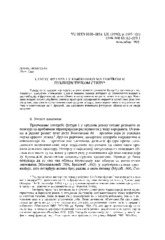Статус футура I у књижевноумјетничком и публицистичком стилу
The Use of Future One in Literary and Journalistic Style
| dc.creator | Војводић, Дојчил | |
| dc.date.accessioned | 2018-05-19T18:30:39Z | |
| dc.date.available | 2018-05-19T18:30:39Z | |
| dc.date.issued | 1996 | |
| dc.identifier.issn | 0350-185X | |
| dc.identifier.uri | https://dais.sanu.ac.rs/123456789/3135 | |
| dc.description.abstract | This paper focuses on the usage of Future One forms in Serbian viewed from the aspect of regional differentiation. More precisely, regional diversity together with their distribution and the frequency of occurrence, was the principal criterion for establishing the standard usage of the mentioned linguistic forms. The same criteria were also applied for the delimitation of the Future One forms from the similar constructions conveying volitional meanings (the translations of their equivalents in Russian, Polish and French are provided in this paper to support the argument). After analyzing the style of literary as well as journalistic texts (functional styles unmistakably reflect the actual usage on the whole of the territory on which Serbian is spoken) it can be concluded that the variant Future + infinitive prevails while on the other hand its syntactic equivalent consisting of conjunction 'da' + present is rather rarely used. On the basis of these findings it can be argued that, in case of usage of Future One forms, the differentiation between a 'western' variant (ja ću pisati) and its 'eastern' counterpart (ja ću da pišem) is irrelevant. The author also emphasizes the fact that the choice of the mentioned forms, from the part of the speaker, is to some degree determined by his dialect background. This influence can be particularly detected in literary works and is manifested in the uneven frequency with which two parallel uses of Future One occur. | en |
| dc.description.abstract | U radu se (s aspekta teritorijalne raslojenosti) razmatra futur I u srpskom jeziku. Analizom odabranih književnih djela i dnevnih novina dobijeni su statistički podaci o distribuciji i frekvenciji datog oblika i njemu sličnih voluntativnih konstrukcija. Navedeni podaci, pored utvrđenog stepena prostorne raširenosti (ograničenosti) ovih jezičkih sredstava, poslužili su kao osnovni kriterijumi za određivanje normativnog statusa infinitiva i kompozicije da + prezent, kao sastavnih elemenata futurskog oblika koji se ovdje proučava. | sr |
| dc.rights | openAccess | |
| dc.rights.uri | https://creativecommons.org/licenses/by-nc-nd/4.0/ | |
| dc.source | Јужнословенски филолог | |
| dc.title | Статус футура I у књижевноумјетничком и публицистичком стилу | sr |
| dc.title | The Use of Future One in Literary and Journalistic Style | en |
| dc.type | article | |
| dc.rights.license | BY-NC-ND | |
| dcterms.abstract | Vojvodić, Dojčil; Status futura I u književnoumjetničkom i publicističkom stilu; | |
| dc.citation.spage | 107 | |
| dc.citation.epage | 121 | |
| dc.citation.issue | 52 | |
| dc.type.version | publishedVersion | |
| dc.identifier.fulltext | https://dais.sanu.ac.rs/bitstream/id/20870/3213.pdf | |
| dc.citation.other | (52): 107-121 | |
| dc.identifier.rcub | https://hdl.handle.net/21.15107/rcub_dais_3135 |
Files in this item
This item appears in the following Collection(s)
-
Јужнословенски филолог / Južnoslovenski filolog
ISSN 0350-185X; eISSN 2406-0763

